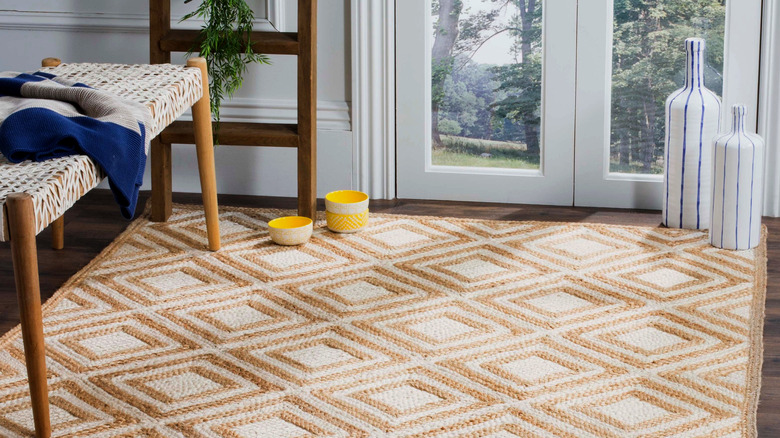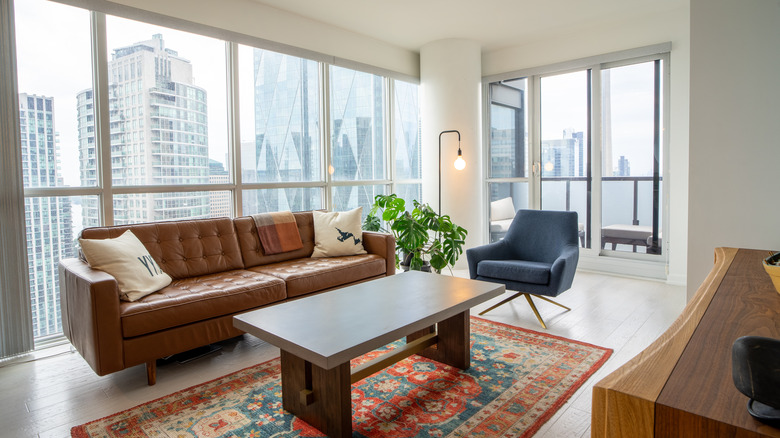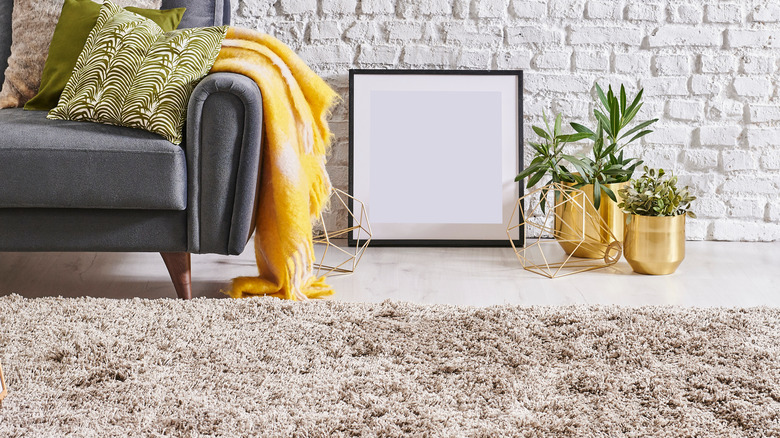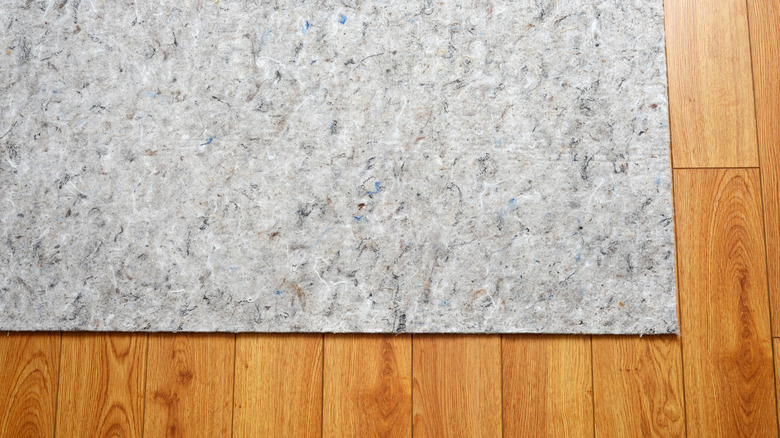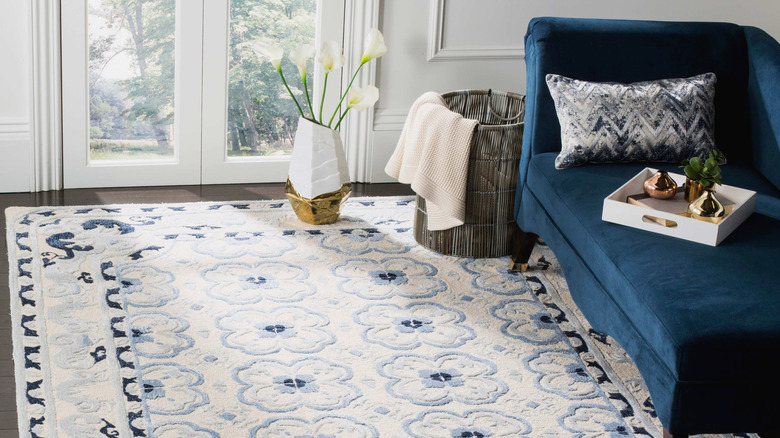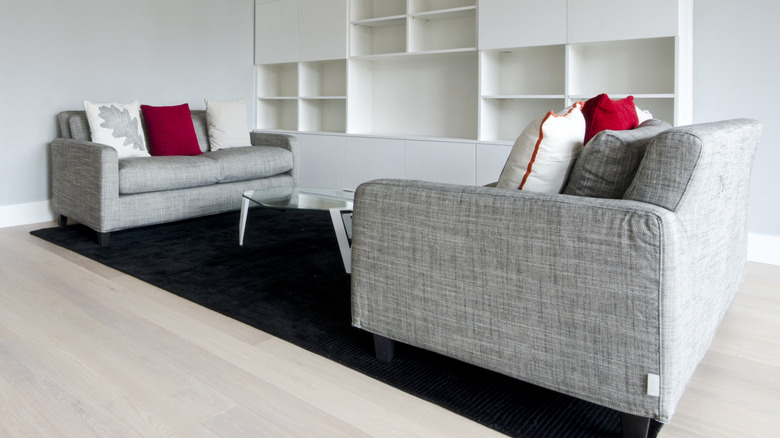Common Mistakes People Make When Choosing A New Rug
Though they may seem like just another textile, rugs have an enormous impact on a room. When it comes to the overall design of a space, they can be absolutely transformational, functioning as that little something extra that takes a room from beautiful but boring to chic and cozy. The Interior Editor even likens rugs to shoes — they complete a room, just as your footwear completes your look. Except they're in a bit of a tricky category, as they're essentially decorative elements, but they take up far more room and visual space than things like throw pillows or accessories artfully displayed on your bookshelves, and thus require a bit more thought. The whole process of finding the right rug for your space can be so intimidating that you may even be tempted to skip it altogether — after all, if your flooring is nice, you don't really need something extra, right? Well, while you don't strictly need a rug, it can really make a difference with your room's design and help tie everything together, so you may want to think twice about avoiding the purchase.
Even though any design decision is ultimately all about preference, there are a few common mistakes that people make time and time again when choosing a new rug. If you keep those mistakes in mind during the selection process, you should be able to take home a piece that you truly love and that works in your space.
Picking a rug that's too small
The most common mistake people make when choosing a rug, hands down, is selecting something that's too small. Buyers end up picking something that's too small for their space for multiple reasons. First of all, as anyone who has bought a rug knows, they can be quite pricey, and typically the larger the rug, the higher the price tag. You may be tempted to go a bit smaller just to avoid that sticker shock, warns Emily Henderson. However, another issue is just the average buyer's perception — something that's 7 feet long seems absolutely massive, but it may actually not be big enough, depending on the space. If you make this particular design mistake, you'll usually end up with a room that feels a bit too crowded, or worse, with a "floating rug" that's awkwardly positioned in the middle of all your furniture.
While it does depend on the overall size and layout of the space, a good rule of thumb is that you want to have all of your furniture legs on the rug itself if possible, with a few inches extending past the legs (via My Domaine). This means that for your dining room rug, you want there to still be a portion of the rug where you pull the chair out. If you have a smaller space, you can make it work by just having the front legs of your furniture pieces on the rug.
Selecting the wrong material for the room
It's easy to fall in love with a particular pattern or texture on a rug, but appearance isn't the only thing to consider when buying one. In fact, one of the key factors to think about if you want to avoid making a common mistake is what the rug's function is in the space you'll be placing it, and what would serve that particular space, per Rug Knots. For example, areas that receive a lot of traffic or where spills are more likely, such as dining rooms, will likely be best served by a low pile rug with a more forgiving material, like nylon or polyester. You won't get as many unsightly marks made by furniture as you might on a rug with a higher pile, and it'll be much easier to clean anything that goes wrong.
On the other end of the spectrum, if you're designing a living room, movie room, or some type of cozy space where you want everyone to relax, that could be an ideal spot for a luxuriously soft rug with a high pile. If durability is one of your major concerns, a low pile rug made from natural fibers tends to last longer (via Love Your Rug). Or, you may be willing to sacrifice durability in order to get that super comfortable space you're looking for. Whatever your preference, just make sure to take the material of any rug into consideration when making your purchase.
Not buying a rug pad
We totally get it — you're already shelling out a decent chunk of change to buy the area rug itself, and the thought of adding even more expense to the purchase with something that goes underneath the rug and isn't even visible seems maddening. However, not buying a rug pad is a fairly common mistake that can be easily avoided by just, well, buying the rug pad! Now, if you're layering a rug over carpet, it's not as much of an issue. But if you're placing a rug over hard flooring such as hardwood or tile, a rug pad is an absolute necessity, according to Decor Interiors.
First of all, from a safety perspective, a pad will help prevent your rug from sliding or slipping around on the floor, which can actually be a hazard. Second, from a comfort perspective, even if the rug you purchased is relatively soft, a pad will add that extra little bit of support (via Sisal Rugs). Finally, for those avoiding purchasing a rug pad because of frugality, know that they can actually help extend the life of your rug, as even a moderate amount of sliding around can cause premature wear and tear. Rug pads are nowhere near as expensive as the rugs themselves, and you can avoid this common mistake by simply adding a little bit of padding (pun intended) to your rug budget to accommodate the crucial accessory.
Choosing a rug last when you decorate a space
Since it's not a furniture piece like the chairs, sofa, or tables that you're adding to a particular room, many leave the rug until last, when they're considering what decor accents to add. However, according to Katrina Chambers Life & Design, this is actually a big mistake, because a rug is an anchor for the space. If you've already picked all your other pieces and determined an overall color palette, you may have a tough time finding a rug that ties it all together and works with everything in the room, from the furniture to the accessories.
Instead, it's often easier to get a rug earlier in the design process — then, you can pick out some of the colors or textures in the rug and either purposefully add contrast with the other elements in the room, or find pieces that coordinate with it. There are certain pieces that may already be in the space, such as larger or old furniture items that you're not replacing, but having as little as possible in the room when you buy the rug can be extremely helpful when it comes to visualizing what would work and determining what you should buy. Given what a visual impact they have and how much square footage of floor they cover, a rug is a major feature in any room — treat it as such by making it one of the first things you get for a space.
Keeping things too neutral
One of the toughest parts of deciding what rug to get for a space is the sheer variety of colors and prints on the market. You could go for something with more of a vintage vibe, choose something with an abstract pattern, or you could select a classic black-and-white color palette, or find a bold hue that adds a splash of color to your room. The options are truly endless.
And yet, one mistake that many people make is staying too neutral, thinking that beige is their only option if they want the rug to work with the other colors and patterns already in the room, notes Katrina Chambers Life & Design. While there's certainly nothing wrong with selecting a rug with a neutral color palette, you also shouldn't be afraid to add some personality with a bolder selection. You do still want to consider the other elements in the space — for example, you probably don't want a rug that clashes with your curtains and couch, or one that blends in with your current flooring. However, if you do like bold design, don't be afraid to steer clear of the neutral gray and cream options and select something with an eye-catching floral or geometric pattern, or to contrast your modern aesthetic with a classic Persian-style rug.
